Learn what no FEA expert ever revealed to you about simulation…
Designers are often catapulted into simulation jobs
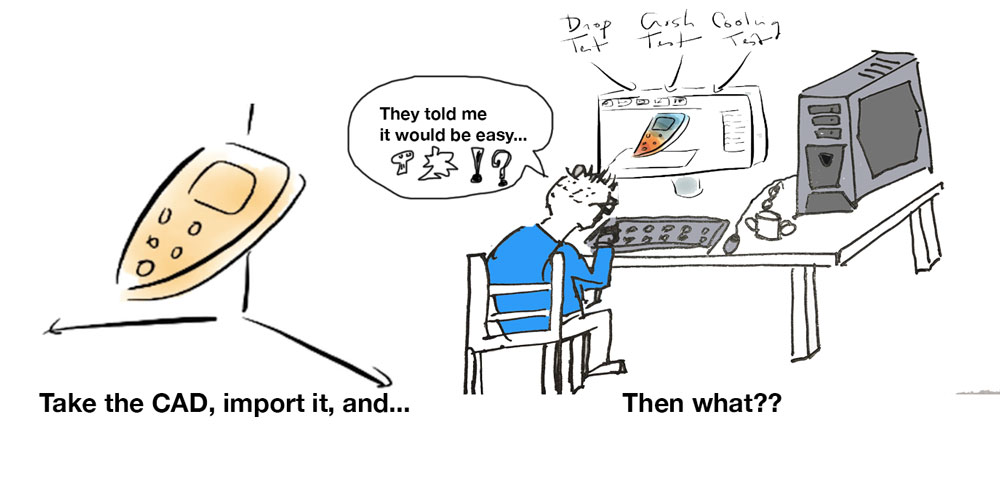
A lot of people think that because you know how to model in 3D, you know how to simulate a model as well!
WRONG.
CAD (Computer Aided-Design) is different than CAE (Computer Aided-Engineering)
One is about design, the other is about engineering.
There is a massive leap to go from one to another.
Nevertheless, managers and clients will often expect designers to perform FEA simulation
How to handle FEA with only a few tutorials and a software (which is often not even appropriate)?
Managers expect results and they don’t care too much about how you do it.
Just read this comment from one of my reader!

Do the simulation results really matter? Does it has a big influence on the company?
YES and YES
Let me give you an example (it will probably sound familiar to you)
A company that design a certain type of product for years (sometimes decades) decide to « innovate » and create new products.
They bring their best designers around a meeting table, ask them to do their best and give them a deadline to “invent” a new innovative product.
What do the designers do?
They make a few changes on a previous design that « look innovative » and a new design is created.
(It is NOT a coincidence if all the new designs out there look like the previous new designs ;-D )
But to tell the truth, that’s not really the designer’s fault, because there is usually no time to think too much about outstandingly innovative stuff.
And about the implication of the changes on the product?… There’s even less time for that… because the sales don’t wait… right? (If you recognize your manager here, you are probably not the only one)
Then, what happens?
The company choose to trust their designers and then launch the product and wait…
After thousand of clients purchased the new product, they finally realize that the product has a huge flaw that makes it unusable… it explodes!

(We are all too familiar with this story… that’s exactly what happened to Samsung recently with its galaxy note S7… but other companies did the same)
Clients are angry, swear that they will never buy the brand again…they lose trust in the brand!
The company is in turmoil. Calls back the products. Lose a LOT of profit.
Why did that happen?
In the case of the Galaxy S7, it was the fault of a cable that was too close to the battery.
Seems like an insignificant detail at first… not the kind of change that need to be tested… or so the designer thought!
The consequences for the company? Catastrophic.
Could those problems have been avoided?
Yes, of course. With the virtual tools that simulation provides, such kind of problem can be avoided through rigorous testing of the product.
By the way, it’s funny to see that now Samsung is advertising about how much their testing facility and simulation processes are great…
Why do you think they do that?
…Because they know that simulation and testing is the right answer to solve such problems… and also of course because they have to regain the trust from their previous fans (Good luck with that).
Why aren’t all designer engineers proficient with FEA simulation to check and improve their product design?
Well… learning FEA simulation is often easier said than done.
There are still many barriers to use FEA smoothly from the start.
The main challenges of FEA Simulation
The FEA Software is just a tool
There is a LOT of disinformation about FEA Simulation out there… mainly for one reason.
Companies who sell FEA Software would like you to believe that their software is the answer to your problems.
They will show you colourful results on simple tutorial models and tell you that solving this kind of model in your real project will be as fast and you will only have to push one or two buttons…
Please, cut the crap…
FEA simulation is about engineering, so you have to actually understand the physics of your problem and the assumptions on it to be able to simulate it.
… in one phrase: you have to know what you are doing
Unfortunately, designers generally realize that only AFTER the company purchased the software…
And then, no one will be there to help you when you will be stuck on your real model!
Garbage in-Garbage out
A lot of people actually get that quickly… the results you get from simulation cannot be more accurate than what you actually provide the software with.
If you provide garbage data, you get garbage results, and that’s with a 100% of probability.
Getting accurate results that describe the physics of the problem
When designers and engineers understand that they have to actually think about their problem and the physics, that’s when the real challenges of FEA simulation reveals themselves.
Few months ago, I asked to my blog readers what were their main challenges and you can see from the list here that there are a lot of them:
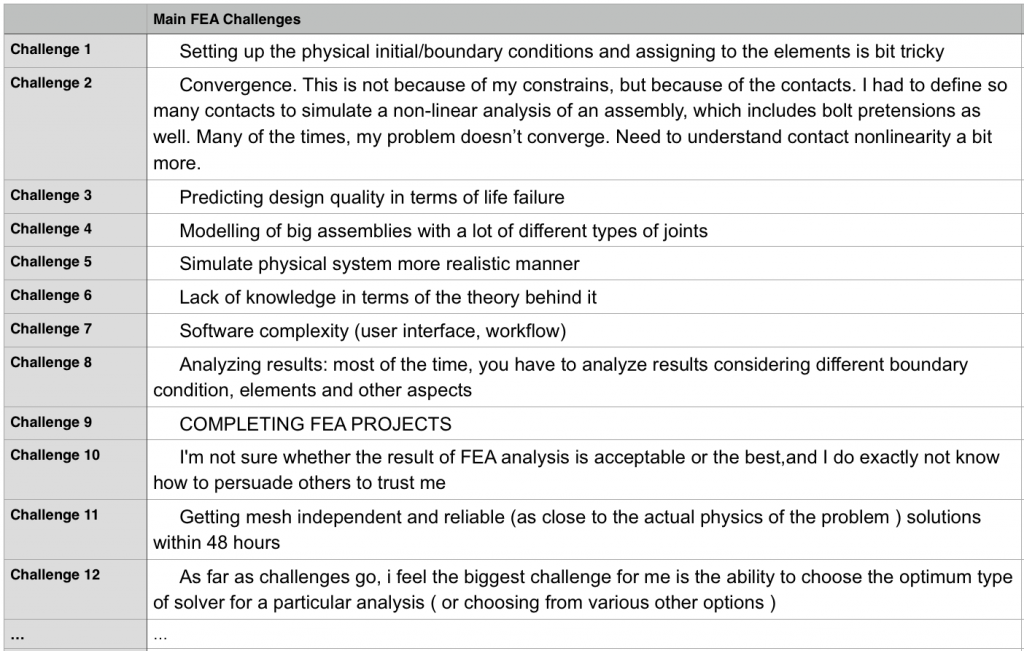
And much more that I couldn’t list here because too specific…
Most of those problems come in fact from one and unique source:
A fundamental misunderstanding of the basics of FEA and how the FEA System works
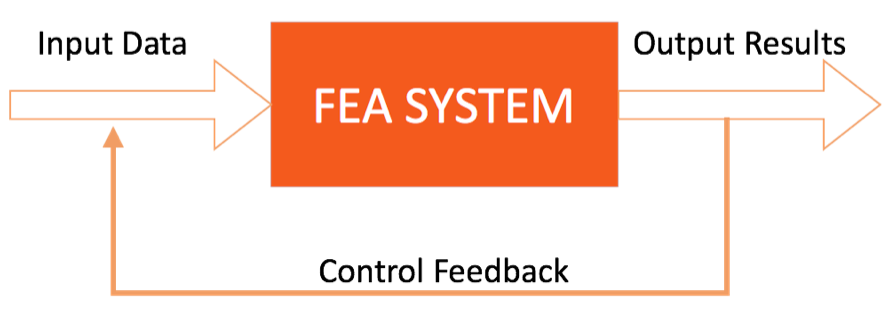
Understanding how the FEA System works and how to harness it to control your results is absolutely critical to the success of your simulation!
Why a lot of design engineers claim that they want to learn and improve their FEA skills but they actually do nothing about it?
I understand very well why we are not always 100% motivated to starting learning the real stuffs because it was exactly the same for me…
We say we want to learn, but then we have another project, we get busy and life goes on…
So…when do we actually take the decision to change and REALLY learn something new that has the power to benefit our lives?
I believe that for most of the people, the answer is when the pain actually becomes absolutely unbearable and we HAVE to learn or something really bad will happen (for example, we will get fired if we don’t do this project correctly…)
Do we really have to wait till THAT point to learn and improve? No…
In fact, preparing yourself to face all the difficulties coming your way and becoming better at what you do is in 99% of cases a much clever way to go than just waiting till the last minute when there is no other choice.
Even if we have to free a bit of time everyday and use it for the sake of self-development.
We have to consider learning as an investment into ourselves.
Starting to simulate product with the right knowledge of the basics will enable you with an priceless new power:
Solving any FEA challenge that you encounter by yourself whenever you meet that challenge!
Interested? Keep reading
From where do I even begin learning FEA?
One of the main problems of FEA beginners is that there are so many things to know that it’s difficult to spot right away where you should start learning…
Fortunately for you, I have been asking myself the same question for years…and it’s only after going through all the possibilities that I finally figured out how to learn FEA the most efficiently…and in an enjoyable and simple way at the same time.
(University professors tend to make simple things over complicated, that’s why I like to do the complete opposite…)
So… Whether you are a student, future mechanical engineer, a mechanical designer currently working for a company, a consultant, a small engineering business owner, or anyone else who needs FEA…
There are some things to know FIRST about FEA analysis.
If you are just listening to the companies selling FE software, you will start to think the world is a beautiful playground for design engineers who are just asking for getting the best available software to create miracle designs and change the world.
They will show and give you tutorials that have been studied and practiced for years to show you their software works 100%… But then when you will meet a real project, that will be another story (and they won’t be there to support you obviously)
Let me bring you to the REAL world… (sorry)
FEA isn’t a way to get colourful mechanical models that pop into the eye…
If you are a design engineer, you know probably that a software is just a tool. It can make your job more efficient…but you still have to do your engineer job. The software won’t give you clues about how to design a product, it will just do what you tell it to do and if you input garbage in, you’ll just get garbage out.
If you are an engineer-manager thinking to invest into an FE Software to earn more, save money on your projects and advance your company’s competitive edge in the market, then you have some serious reasons to ask yourself if investing in an FEA software is really wise, if yes, why and how do you justify and ENSURE that the software will bring you some ROI? The answer isn’t easy.
If you are a student who wants to become a mechanical designer or a future FE analyst to create the products of the future, then you will need to learn much more than just following up a few tutorials provided for free on internet to start to really understand how it works.
If you are a consultant doing FE projects, you may need to explain clearly in simple terms how FE analysis can solve the problems of your clients and how it will bring back their money investment and help them to mitigate the risks in their product line.
Who am I, by the way?

My name is Cyprien Rusu, I am a CAE engineer who wants to teach the right bases of FEA Simulation to designers, engineers and everyone aspiring to get it right!
Hundreds of FEA students followed my free FEA webinars on Youtube, read my blog articles on feaforall.com and joined my FEA courses to learn more and improve their understanding of FEA and become better engineers!
The FEA courses I create are the most easy to understand material available on internet!
I have taught FEA seminars to FEA engineers from all over the world…

And now I am taking that experience to you into my first series of online FEA courses!

Introducing FEA Design System 1-2-3-4: Create your ever-converging FEA System and Master the Art of Virtual Prototyping
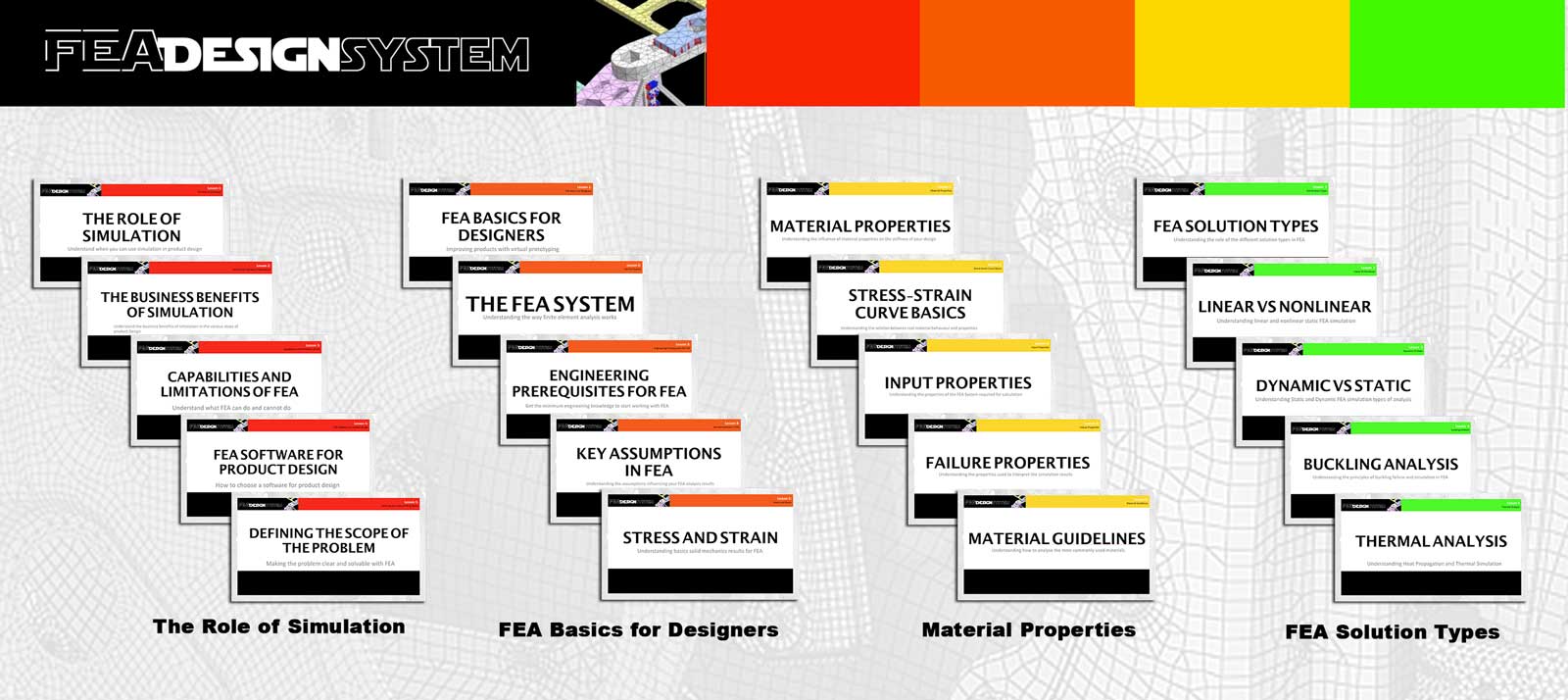
My courses separate into several levels
My purpose is to bring you from the very first steps to understanding FEA and the concepts behind it to an advanced FEA Analyst Engineer.
For that, I needed to have a gradation in the level of difficulty of each course.
A perfect beginner should start from the course 1 and go over all the series in order to acquire all the principles that you will need in your FEA journey.
Remember… starting from the basics is key here!
If you already have some notions of FEA and you did some very simple analysis in the past, you can probably skip the course 1 and 2 to concentrate directly on the course 3 and 4, which are a level higher in difficulty.
Then, finally, when you are ready, my more advanced course FEA foundation Perfect BC and Mesh Convergence will take you on some of the often-neglected but essential aspects of FEA Analysis: FEA model building and Boundary conditions setting.
You can click on each separate course page to read the details about each course:
Course 1:
FEA DESIGN SYSTEM 1: THE ROLE OF FEA SIMULATION
This course is about understanding the role of simulation in product design. In its 5 lessons, you will learn the role of FEA Simulation in product design, the business benefits of simulation, the capabilities and limitations of FEA, how to choose an FEA Software and how to determine the scope of your analysis.
This course is recommended to engineer-managers, designers or engineers who plan to acquire an FEA software for their company or simply people who want to understand the full picture and role of simulation in product design to have a greater impact on their company and the products they design.
Read the Details about this Course
Course 2:
FEA DESIGN SYSTEM 2: FEA BASICS FOR DESIGNERS
This course introduces some fundamental notions of product design with FEA simulation and defines how the FEA System works illustrated with simple examples to understand the concept. It will also give you some engineering pre-requisites that are fundamental for FEA and an understanding of the Key assumptions that you have to always remember.
This course will benefit you the most if you are someone planing to use FEA soon for design projects or if you already use FEA, but you would like to understand how you can use it in a more systematic way to decrease the risks of error and improve the accuracy of your results.
Read the Details about this Course
Course 3:
FEA DESIGN SYSTEM 3: MATERIAL PROPERTIES
This course includes all the fundamental notions about materials that you need to know to start simulating different types of materials. It will provide you with an understanding of the various material assumptions, the properties required in your FEA software to represent those material and it will give you as well some basic guidelines to simulate various kind of materials such as steels, plastics, weldments or castings.
This course will benefit you the most if you are a design engineer using simulation to check and improve your design and if you want to avoid the basic material linked mistakes and understand more closely the relation between material properties and your simulation results.
Read the Details about this Course
Course 4:
FEA DESIGN SYSTEM 4: FEA ANALYSIS TYPES
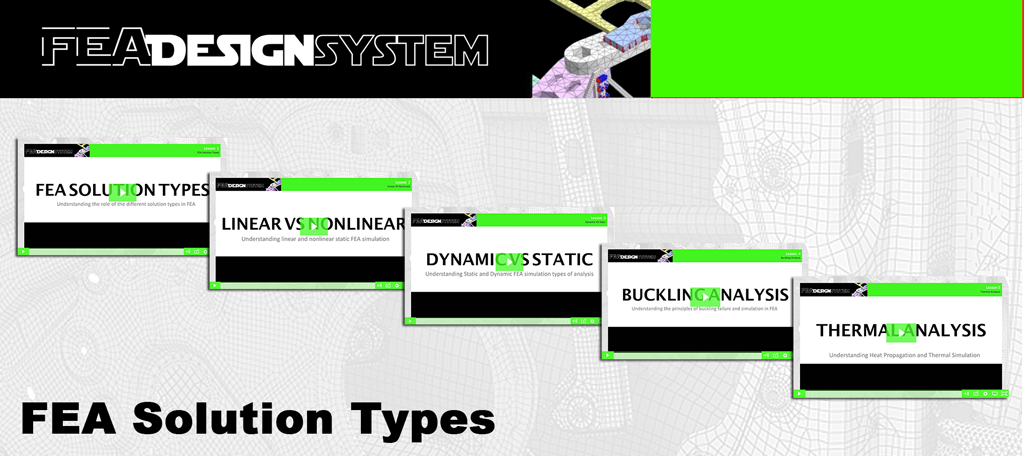
This course focuses on the physics and includes all the foundational knowledge about the main types of physics. It will take you from a basic linear analysis to a nonlinear along with reviewing all the notions you should know about to perform more advanced analysis types. It will also give you some solid basics about dynamics and vibration (modal analysis, transient and frequency response, drop test) in order to help you to simulate both static and dynamic systems confidently. Then the last 2 parts of the course will introduce you to buckling analysis and thermal analysis to provide you with a wider view of the simulation landscape.
This course is a MUST have if you are a designer who wants to go further than the most simple linear static analysis in order to be able to design any type of linear, nonlinear, static or dynamic system.
Read the Details about this Course
*Bonus: 7 Dynamic Case Studies
As a limited time bonus to that course, I will provide to you 7 case studies to understand more in depth dynamic analysis.
I was initially keeping those full step-by-step case studies for a more advanced course solely focused on dynamic analysis, but I decided to provide them to you along with the course “FEA Design System 4: FEA Analysis Types” in order to complete the course.

Course 5:
FEA FOUNDATIONS: MESH CONVERGENCE

This course is an advanced FEA course teaching about FE model building, mesh creating and mesh convergence related topics. It will provide you with an advanced understanding of the various types of FE models, mesh elements and their impact on your results. It will also give you some important strategies to build up the right model that fits your analysis goal.
This course will benefit you most if you are a CAE engineer who know already the basic notions of FEA and you are trying to improve your skills of FE modelling to build better models.
Read the Details about this Course
Course 6:
FEA FOUNDATIONS: PERFECT BC
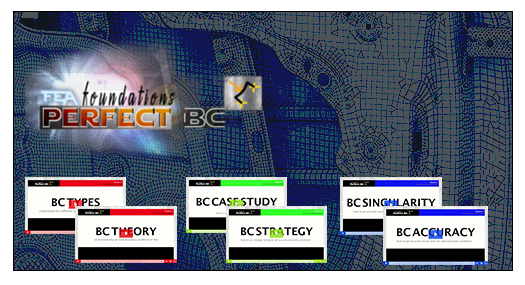
This course is an advanced FEA course teaching about boundary conditions in depth. It describes in depth what is a boundary condition, the different types of boundary conditions and provide some strategies to assign boundary conditions in your model to obtain the most accurate results.
This course will benefit you most if you are a CAE engineer who know already the basic notions of FEA and you are trying to improve your skills of FE modelling to build better models.
Read the Details about this Course
COURSE PACKAGES – LIMITED TIME OFFER
[tminus t= “29-07-2017 09:00:00”]The Offer has already expired.[/tminus]
OPTION 1: SINGLE COURSE PACKAGE
Get only the course that you need to improve your FEA skills in the particular topic that is important for you. Each of the course can be purchased separately by going on its dedicated course page. Current price for each course will increase in the future while more and more material will be added to it, so get it at a low price while you have the option and you will get the future updates to the course free of charge.
FEA DESIGN SYSTEM 1: THE ROLE OF FEA SIMULATION
FEA DESIGN SYSTEM 2: FEA BASICS FOR DESIGNERS
FEA DESIGN SYSTEM 3: MATERIAL PROPERTIES
FEA DESIGN SYSTEM 4: FEA ANALYSIS TYPES
FEA FOUNDATIONS: MESH CONVERGENCE
OPTION 2: BASIC FEA DESIGN SYSTEM PACKAGE– 20% Discount
This package contains the 3 FEA Design System Courses:
- FEA DESIGN SYSTEM 1: THE ROLE OF FEA SIMULATION
- FEA DESIGN SYSTEM 2: FEA BASICS FOR DESIGNERS
- FEA DESIGN SYSTEM 3: MATERIAL PROPERTIES
- FEA DESIGN SYSTEM 4: FEA ANALYSIS TYPES
All the 20 lessons are provided in Video format (more than 12 hours of video) and can be downloaded freely. You will also get the PDF version of each lesson so you can print it and review it whenever you want.
You will have access to this course for an unlimited amount of time and you will have access as well to the future additions and improvements to the course material.
OPTION 3: ADVANCED FEA FOUNDATIONS PACKAGE– 25% Discount
This package contains the 3 FEA Design System Courses and the 2 FEA Foundation courses:
- FEA DESIGN SYSTEM 1: THE ROLE OF FEA SIMULATION
- FEA DESIGN SYSTEM 2: FEA BASICS FOR DESIGNERS
- FEA DESIGN SYSTEM 3: MATERIAL PROPERTIES
- FEA DESIGN SYSTEM 4: FEA ANALYSIS TYPES
- FEA FOUNDATION: MESH CONVERGENCE
- FEA FOUNDATION: PERFECT BC
All the 32 lessons are provided in Video format (more than 26 hours of video) and can be downloaded freely. You will also get the PDF version of each lesson so you can print it and review it whenever you want.
You will have access to this course for an unlimited amount of time and you will have access as well to the future additions and improvements to the course material.
What people say about me and my courses:

What if I join and I don’t like the course?
I have a zero-risk policy. If you don’t learn anything important in this course, or even if you simply decide it was not worth the investment, I’ll give you a 100% money-back guarantee up to 30 days after you purchased the course.

How can I join the course?
- Purchase the course by clicking on the Purchase button below
- You will be redirected to the paypal website where you have to enter either your paypal credentials or directly your credit card information if you do not have a paypal account
- After completing the purchase on paypal, you will receive an email with your student login and password
- Using these credentials, you can log into your courses section where you have a lifetime access to your courses
COURSE PACKAGES – LIMITED TIME OFFER
[tminus t= “29-07-2017 09:00:00”]The Offer has already expired.[/tminus]
OPTION 1: SINGLE COURSE PACKAGE
Get only the course that you need to improve your FEA skills in the particular topic that is important for you. Each of the course can be purchased separately by going on its dedicated course page. Current price for each course will increase in the future while more and more material will be added to it, so get it at a low price while you have the option and you will get the future updates to the course free of charge.
FEA DESIGN SYSTEM 1: THE ROLE OF FEA SIMULATION
FEA DESIGN SYSTEM 2: FEA BASICS FOR DESIGNERS
FEA DESIGN SYSTEM 3: MATERIAL PROPERTIES
FEA DESIGN SYSTEM 4: FEA ANALYSIS TYPES
FEA FOUNDATIONS: MESH CONVERGENCE
OPTION 2: BASIC FEA DESIGN SYSTEM PACKAGE– 20% Discount
This package contains the 3 FEA Design System Courses:
- FEA DESIGN SYSTEM 1: THE ROLE OF FEA SIMULATION
- FEA DESIGN SYSTEM 2: FEA BASICS FOR DESIGNERS
- FEA DESIGN SYSTEM 3: MATERIAL PROPERTIES
- FEA DESIGN SYSTEM 4: FEA ANALYSIS TYPES
All the 20 lessons are provided in Video format (more than 12 hours of video) and can be downloaded freely. You will also get the PDF version of each lesson so you can print it and review it whenever you want.
You will have access to this course for an unlimited amount of time and you will have access as well to the future additions and improvements to the course material.
OPTION 3: ADVANCED FEA FOUNDATIONS PACKAGE– 25% Discount
This package contains the 3 FEA Design System Courses and the 2 FEA Foundation courses:
- FEA DESIGN SYSTEM 1: THE ROLE OF FEA SIMULATION
- FEA DESIGN SYSTEM 2: FEA BASICS FOR DESIGNERS
- FEA DESIGN SYSTEM 3: MATERIAL PROPERTIES
- FEA DESIGN SYSTEM 4: FEA ANALYSIS TYPES
- FEA FOUNDATION: MESH CONVERGENCE
- FEA FOUNDATION: PERFECT BC
All the 32 lessons are provided in Video format (more than 26 hours of video) and can be downloaded freely. You will also get the PDF version of each lesson so you can print it and review it whenever you want.
You will have access to this course for an unlimited amount of time and you will have access as well to the future additions and improvements to the course material.
